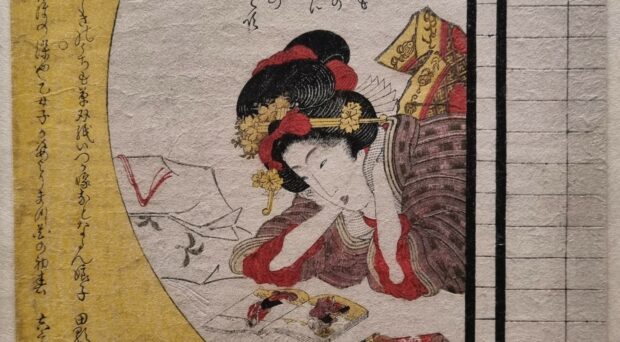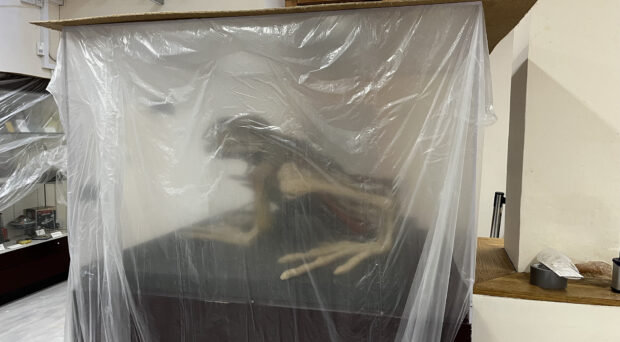The University of Cambridge Museums (UCM) have been running volunteer-led LGBTQ+ tours, Bridging Binaries, since December 2018.
The tours are delivered by a team of brilliant volunteers and explore the spectrum of identities that exist across time, place and culture in our collections. In late 2019, after great audience responses to the pilot tours at the Museum of Classical Archaeology, Fitzwilliam Museum, Museum of Zoology and Polar Museum, we decided to embark on extending the tours to three new collections in our group of museums: the Museum of Archaeology and Anthropology, the Whipple Museum of the History of Science and the Sedgwick Museum of Earth Sciences. (You can find out more about the pilot in our first blog post.)
This meant recruiting and training a new wave of volunteers to lead the tours, as well as collaborating with external consultants Dan Vo and Eleanor Armstrong, to research new content for the three new collections. The tours programme started up again in February 2020 and ran until the museums closed in March in response to the Covid-19 pandemic. While we all try to cope and adjust to our new normal, now is as good a time as any to reflect on the impact the tours project has had on everyone involved so far.

Exploring the impact of the tours project
We know that audiences on the tours have really enjoyed them. The visitor comments speak for themselves:
‘I have visited all of the Museums in Cambridge and have often been left a little sad/excluded by the lack of queer content, so I was excited to engage in a new way.’
‘I [think] the tour would be interesting to people that both identify as LGBT but also that [don’t]… for those that do it would make them feel more welcome in Museum spaces…for those that don’t… [it’s] an opportunity to expand thinking. Particularly in regards to how discrimination and exclusion can lead to faulty or inaccurate research.’
‘It opened up a whole new world that I would never have been aware of if the guide hadn’t taught us about it.’
But what about the volunteers and the Museums?
Over the last two years we’ve been lucky to have a brilliant team of local volunteers who we’ve built new relationships with. They, in turn, have built close bonds with the museums and each other.
Here’s Luis, one of our volunteers, talking about his Bridging Binaries experience:
Looking back over two years of Bridging Binaries, we can see the real impact it’s had on the UCM, from increasing staff confidence and investment in LGBTQ+ projects, to providing a distinctive new volunteer offer (not tried before at the UCM) and the possibilities that have been opened up by Dan and Ellie’s research. We’ve made friends and allies through the project that we would never have expected. It’s precipitated new discussions within the UCM about how we should and could be representing LGBTQ+ stories more permanently across our Museums.
There’s still much to do, though. In particular, we’re wondering: how can we expand the project’s impact from the initial format, and more widely across our organisation? There are only so many people you can reach through a timed tour: how can we make sure that LGBTQ+ history is available to the general visitor? How can we continue to grow our pool of allies within the UCM? And how can we keep up momentum with the project?
In particular the tour content generated by Dan Vo for the original tours in 2019 provided the inspiration for our 2019 Museum Remix project. This project saw the UCM work with external participants to produce a pop-up exhibition, giving voice to LGBTQ+ stories previously silenced by prejudice or historical disinterest. In some cases the resultant artwork produced in response has ended up on display in a few of the Museums.
‘It’s amazing to see some of the stories from the Bridging Binaries tours being told in the permanent collection. The success of the tours has illustrated our visitors’ desire to see these narratives on display, now it’s happening!’’ Museum Remix 2019 participant.

For Museum Remix 2020 some of the stories generated by Dan and Ellie will again provide inspiration for our online version of the project. In addition, the content research has been, and will be, used to produce self-led LGBTQ+ trails in certain museums, and activities aimed at families in the near future.
The high levels of enthusiasm that the project has generated, telling LGBTQ+ narratives across our collections has highlighted how much we still need to do. The majority of the tours content remains ephemeral and isn’t instantly accessible for the average visitor (though we hope the displays and trails will go some way to remedy this when the museums begin to reopen.) What’s more, the stories we are telling, whilst compelling and important, all but scrape the surface. They also often interlink in a myriad of ways with a range of concurrent stories or perspectives that remain silenced.
Following the development of the new tour content for new museums, plans and ideas for new activity had begun to be generated with the local community. These ideas for events and activities which hoped to delve further into these narratives, bringing new layers and perspectives are now on hold while the Museums are closed. But it’s up to us to find new ways to make this happen.







